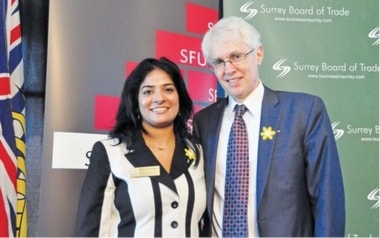SURREY — Subdivisions, strip malls, box stores and – of course – parks were pretty much all that dotted Surrey’s landscape when Mayor Dianne Watts moved to the city in the early 1990s.
Even she admits to not thinking of it as much more than a bedroom community while spending her weekdays commuting to an office in Richmond.
“There was no particular order in terms of anything other than a residential suburb and everybody travelled elsewhere for work,†she told Business In Vancouver. But Watts, who announced last week that she won’t seek re-election after three terms as mayor, wanted to change that. She ran for city council in 1996, winning her seat in the chambers after initially being written off as a long-shot candidate.
After three terms as a popular councillor, she departed the Surrey Electors Team in 2005 and ran for the top office when her working relationship with then-mayor Doug McCallum soured.
“She knocked off our mayoral candidate, so that wasn’t nice of her,†recalled Surrey-Panorama Ridge MLA Marvin Hunt, who has spent 25 years on city council while Watts, McCallum and Bob Bose took turns in the mayor’s office.
But unlike McCallum’s more brash leadership, Hunt said, Watts’ style was more conciliatory to politicians and businesses while she cultivated the right environment to transform Surrey from a suburb into a city capable of supporting jobs beyond the service industry.
Hunt – along with every single city councillor elected to office during the 2011 campaign – eventually joined Watts on the Surrey First Team.
The MLA added it wasn’t until the current mayor’s era that “innovative industries†ramped up investment in Surrey.
Green startups like Endurance Wind Power set up shop in town while Coast Capital Savings invested more than $100 million in building a new head office next to the King George SkyTrain station in Whalley.
The number of business licences issued to companies nearly doubled between 1996 and 2014, according to the City of Surrey, growing from about 8,000 to 15,000.
Meanwhile, the dollar value of residential, commercial, industrial and institutional building permits more than doubled, rising from $600 million in 1996 to $1.3 billion in 2013.
Surrey Board of Trade CEO Anita Huberman said the city’s brand was one of the most significant changes Watts brought about.
“Before she came into office, Surrey was often [taking] the brunt of many jokes,†she said.
“It impacted business attraction strategies, things that we wanted to do that were innovative for the city.â€
By 2006, cheap land and low taxes were enticing enough to South Korean developers to announce plans to build the largest real estate project in Surrey’s history.
But the 2008 financial crisis brought construction of the $350 million development to a screeching halt when its primary backer, Lehman Brothers Inc., filed for bankruptcy protection.
Although one building had already been completed, plans for the remaining four towers next to the King George SkyTrain station were left in limbo for months.
Watts said despite the economic uncertainty, she wasn’t concerned the city’s real estate projects would collapse under the cash squeeze.
“What I didn’t want to do is have [developers] just take a step back,†she said. “We put in the economic investment zone [in the downtown core]. That really gave investors a level of certainty.â€
In the aftermath of the downturn, investment in real estate projects dropped 32%, from $1.2 billion in 2008 to $860 million in 2009. By 2010, it jumped back to $1.2 billion.
Watts said projects such as Innovation Boulevard will leave those shaky economic times even further behind, creating a job base that’s less reliant on construction.
The network of health institutions, private companies and universities working in facilities within a square mile of the city centre was launched to cash in on the booming health-tech sector and further develop Whalley’s infrastructure.
“Mayor Watts, from my observation, has certainly accelerated [sustainability initiatives] and has … seen the opportunities for Surrey to operate in a way that defied the expectations of what can be done in a suburb,†said Patrick Condon, a professor at the University of British Columbia School of Architecture and Landscape Architecture.
Condon began providing expertise in sustainable urban design to Surrey in the early 1990s.
He said the sprinkling of high-rise towers in Whalley is dwarfed in significance by the myriad low- to mid-level buildings that were built under Watts’ watch.
“Things that were considered impossible in 1990 are now just considered routine.â€
For more stories from Business in Vancouver, click here.
